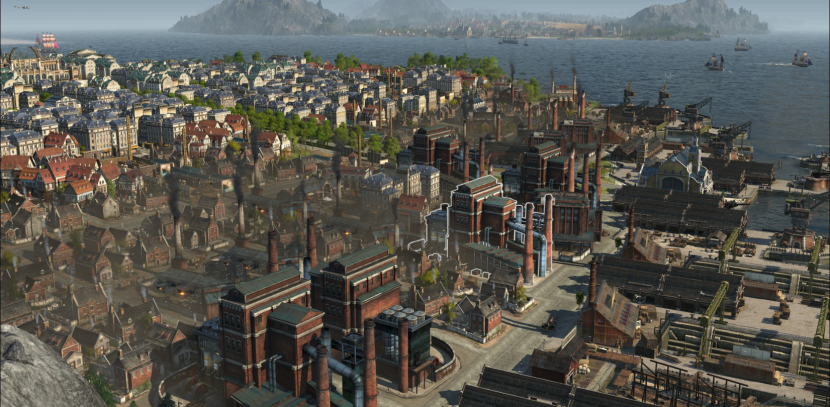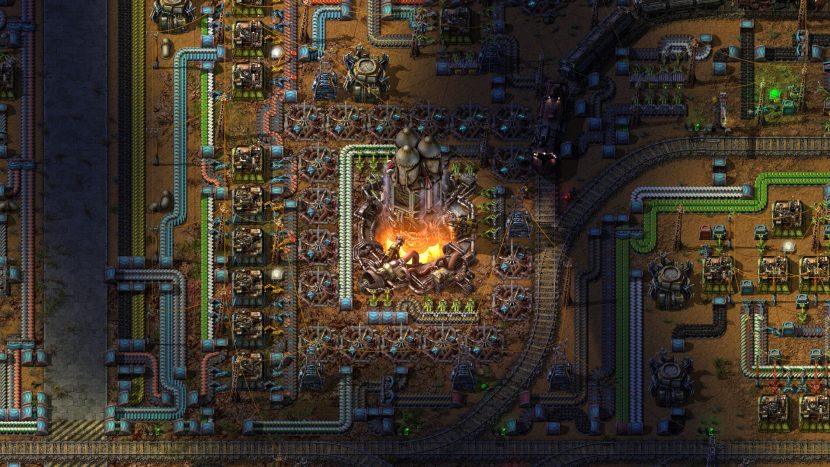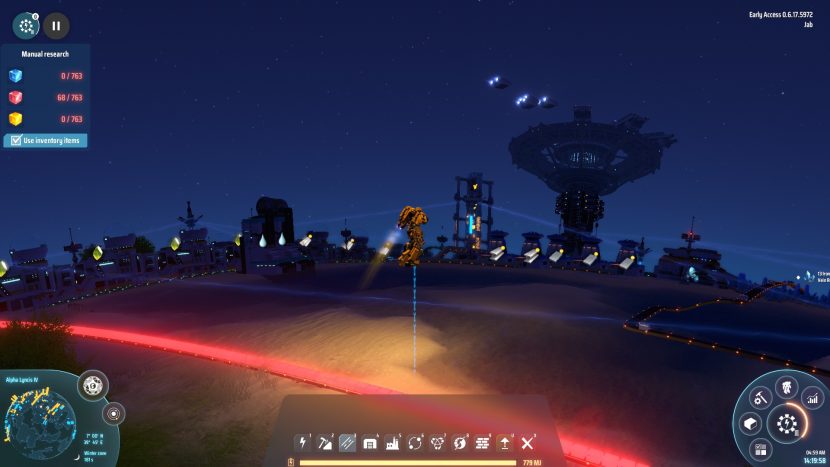Everyone plays videogames for different reasons and there are fans of all sorts. Some of you reading this love to see the “you win” sign appear on a fighting game, maybe you really like saving Princess Peach with some platforming or enjoy wandering the land with Geralt. For today, I want to talk about one of the most niche genres and why there are fans like myself who just love watching stuff move from point A to point B.
A Game of Logistics
One of my very few developer chats which sadly cannot be viewed was an email correspondence with Chris Beatrice who was the lead designer at Impressions and Tilted Mill. Speaking with him, we had a massive conversation about city-building design and the state of the genre back in 2012. From that conversation, we spoke about how there was a huge difference between city builders and logistics/optimization games like Anno, Factorio, Satisfactory, Logistical, Final Upgrade, and Dyson Sphere Program.
Both genres (I’m not including idle games even though they are optimization games) are essentially offshoots from real-time strategy: the player constructs buildings, said buildings produce something, the player uses that something. The difference with city building, and why it is so specific, is that city builders are supposed to simulate the needs and desires of the citizens. This is where the concept of the walker system that has been used heavily by the genre comes in. The point of a city builder is to watch how your city and the people in it interact with each other. Because you are focusing on the needs of the people, and how those needs can change, there isn’t really the ability to create a 100% optimized city.

city builders simulate citizens and their needs, and can never fully achieve a perfect balance because of it
Logistics games may have cities and people in them, but they are nothing more than number generators. In Anno 2205 I had literally islands of thousands of workers whose only reason for existing was to pay me money while they sat around all day consuming water and ramen.
In a logistics game, there is no confusion about how things work or ways to influence it. If the game tells me something will happen in three minutes, five seconds, 2 milliseconds from now, then that’s when it’s going to happen.
Given the set nature, and the lack of simulation going on, you may think that logistics games are very basic in their gameplay, but these games are all about finding creative solutions to ongoing problems.
Creative Construction
As I said at the start, people don’t play logistics games for high octane action or involved stories, but for dealing with an infinite number of small problems. At its core, you can solve any issue in a logistics game by doing every construction by hand. Of course, this is anathema to a fan of logistics games, and where the core gameplay loop begins to take shape.
Every game starts with the first challenge of gathering the essential resources you need. This is slow, ponderous, and can feel like pulling teeth out in terms of walking around to each resource node in the area. And that presents the first problem to solve: How do I automate this? With each new production chain set up, the player is solving a problem that they are personally dealing with, and that is a powerful motivator for progression.
New researches and upgrades will unlock something new, make something the player is using better, add a new wrinkle to the production, or all the above. Earlier in this post, I mentioned idle games, and while they are not part of this discussion, they do feature similar gameplay loops — you are making numbers go up to make other numbers go up.
The reason why logistics games become so personal is that while the game does have an intended path through, the player is in complete control over their progress. One person may decide that they are fine with manually crafting a certain item, while someone else will not move on until every constructible item is being automated. And over the course of playing, how the player approaches these tasks will change based on the tools available and their own knowledge of the game.
DSPFTW
The game I’m currently enjoying is Dyson Sphere Program, while it’s still in early access with more content coming, at the moment it is one of my favorite takes on the genre. The game is set up similar in tone to Anno 2205, your mission is to solve the energy crisis, this time by building a Dyson sphere. What may prove to be a controversial opinion, I like the fact there is no military/combat system to distract. This is a game that is all about optimization.
You are literally given a universe to harvest resources from and use to build your elaborate assembly lines, and that’s where DSP differs from Factorio. Factorio is more micro-oriented, and the intimacy of not only setting up production chains but building the necessary defenses and weapons to keep you alive. Whereas DSP wants to send you out into the galaxy to set up larger and larger production chains.
A major part of what makes DSP interesting is the larger scale and being able to solve your production and resources problems by literally traveling to different star systems. This is handled well by how production works. Many of the mid to late-tier items will often require goods that need multiple resources. By exploring the universe, you may find rare resources that can skip production steps and reduces the number of resources and space needed to make the same product.
One major point where DSP takes a turn in terms of optimization is with the introduction of “logistics towers” that show up around the mid-game on the research tree. These towers serve as storage areas for your goods and allows transportation between towers using drones. With their arrival, the need for planet-spanning conveyor belts is over, and this prepares the player for the next stage of their optimization. The goal then becomes setting up factory systems that essentially run themselves provided there are resources in their respective towers. I spent a good three hours completely rebuilding my factories to “future proof” them for my needs going forward.
There is this great sense of growth in DSP and being able to see that not only on your starter world but exploring the galaxy that I haven’t really seen done before in logistical games. The fact that it is this good now while it still has plenty of time in early access speaks volumes about the pros of this design. With that said, logistical games are a lot harder than just having numbers go up.
Stuck in a Loop
When I look at other logistical games, and even idle design, there are a few areas where I see novice developers miss the point on. The first is having a reliable “carrot on the stick” to keep players engaged. Progress in this kind of design is about a lot of small incremental goals, not one giant, “20 hours later” grand project to achieve. The player needs to feel like things are going in the right direction, not just standing still.
This is where the upgrades and unlocks come in. Good design is about providing the player with enough starting tools that they can already get a sense of how to design their production lines, while still having unlocks of greater complexity and utility down the line. In DSP, one of the major progression points like Factorio is producing and automating “science cubes” that are used for tech. For each new cube unlock, you are going to have to spend some time reconfiguring your lines to accommodate the increased yield.
One area where DSP falters at the moment is that the big push into the universe is not as grand as you would think. While systems come in different star types, what you’re doing on each planet does not change. You are still going to have one or two “factory worlds” that do all the production and refinement, everything else is just mining colonies. And this is one area where I would like to see more diverse options and elements in future patches.
UI/UX is often a major stumbling point. Logistics games at the end of the day are just slightly above idle games as being “UI the game.” Elements like hotkeys, camera controls, and even an easy-to-understand main screen UI, are essential. One of the major problems that was in Anno 1800 at the start was no clear way to spot optimization problems with your islands in terms of not producing enough resources. It took several months before the ability to see your exact production/consumption rate of a resource was added in. The Logistical series is one of the most complicated examples of the genre, but it, unfortunately, has the worse approachability and onboarding of the games I’ve played.

The Anno series has always been about that chase of optimization and then adding new elements to juggle.
A problem with Satisfactory is that I felt the progress at the start is a little too slow. Another area where some developers falter is making the beginning too frustrating or locking too many elements behind progression. That annoying start I mentioned a few paragraphs up? That should only be at most 5-10 minutes of the entire playtime. You want to define essentially early, mid, and late game optimization systems and make sure that the player has ways of making life easier for them at each stage.
Just adding more “stuff” to build is not enough of a hook, there needs to be different rules, procedures, and strategies for building advanced resources. In Factorio the game slowly unfolds additional elements like harvesting liquids, electrical power, the as-for-mentioned defenses, and more. That depth and level of detail is the reason why people have thousands of hours in Factorio.
Unlike survival games where the player is not supposed to reach a point of stability, optimization games are about becoming stable, but that’s not the ultimate goal. The Anno series is all about getting all the different production lines, needs, and transportation stable, and then breaking it with the next thing and doing the optimization dance again.
Shipped Goods:
It’s interesting to me with how far optimization games have come both in terms of aesthetics and complexity. Anno 1800 is perhaps the most recognized in the mainstream, and the most successful of the series to date, now having three years of post-release DLC support. Meanwhile, Factorio and Dyson Sphere Program are two very different takes on similar elements, with massive potential and reach for both.
Not every game needs to be about conflict and saving the universe. Sometimes the greatest stakes needed is trying to fit that one conveyor belt in that’s messing up your entire assembly line and you can’t seem to move any machinery out of the way.
For the reader: Do you have a favorite optimization game, and what attracts you to the genre?
If you enjoyed my post, consider joining the Game-Wisdom discord channel. It’s open to everyone.



